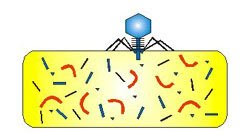4. Replication and Expression
A single virus particle is in and of itself essentially inert. It lacks the components needed to reproduce. Viruses are intracellular obligate parasites which mean that they cannot reproduce or express their genes without the help of a living cell.
Once a virus has infected a cell, it will "marshal" the cell's ribosomes, enzymes and much of the cellular machinery to reproduce. Viral reproduction produces many, many progeny that when complete, leave the host cell to infect other cells in the organism.
The exact nature of what happens after the host is infected varies depending on the nature of the virus. In most cases, the process depends on the form of the genome. The process for double-stranded DNA, single-stranded DNA, double-stranded RNA and single-stranded RNA will differ.
Virus binding to the cell wall

Virus injecting its genetic material

Virus genome replicates 5. Assembly
5. Assembly
Assembly of virus particles occurs in the nucleus. DNA enters the particles after immature capsids are formed. The capsids then undergo a maturation process, after which the cells die and virus leaks out.
Virus components and enzymes continue to be produced
Components of the virus assemble
Virus enzyme breaks down the bacterial cell wall causing the bacterium to split open
6.Release
Viruses may escape from the host cell by causing cell lysis (death). Enveloped viruses (e.g., HIV) typically "bud" off the host cell. Budding viruses do not necessarily kill the cells. During the budding process, a virus acquires the phospholipid envelope containing the embedded viral glycoproteins. Also, not all released viral particles are infectious. The ratio of non-infectious to infectious particles varies with the virus growth conditions.
lOSHiNi





